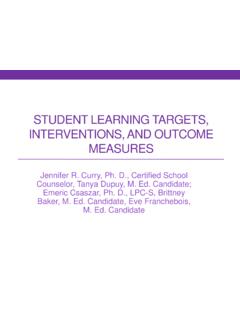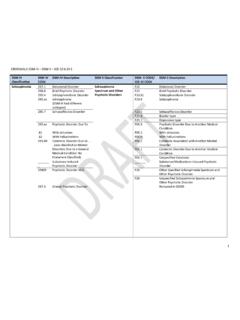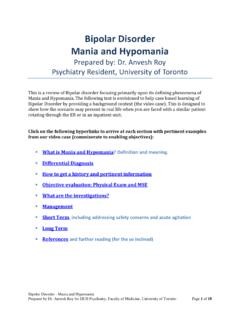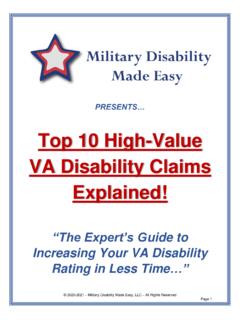Transcription of DSM-5: What Counselors Need to Know
1 DSM-5: What Counselors Need to Know Gary G. Gintner, , LPC Louisiana State University Baton Rouge, LA Disclosures Dr. Gintner has never received any funding or consulting fees from the American Psychiatric Association or from any pharmaceutical company. DSM and DSM-5 are registered trademarks of the American Psychiatric Association. The American Psychiatric Association is not affiliated with nor endorses this seminar. Introduction Why change the DSM? The purpose of a diagnosis Common language Inform clinical care Overview of today s workshop Major Innovations of DSM-5 ICD/DSM harmony Discontinuation of multiaxial system Spectrum disorders and dimensional ratings Greater recognition of the influence of age, gender and culture New organization of chapters DSM-5 Sections Section I: DSM-5 Basics Introduction Use of Manual Section II: Diagnostic Criteria and Codes DSM-5 Section III.
2 Emerging Measures and Models Appendix Organization within Chapters Diagnostic Criteria for particular disorder Subtypes and Specifiers Coding and Recording Procedures Explanatory text information for that disorder Diagnostic features Associated features Prevalence Development and course Risk and prognostic factors Culture-related diagnostic issues Gender-related diagnostic issues Suicide risk Functional consequences Differential diagnosis Comorbidity Use of the Manual DSM-5 uses a single axis system that combines the former Axes I-III: Mental Disorders Medical Disorders Other Conditions that May be the Focus of Clinical Attention ( , V codes) Is there a way of noting contextual or situational factors like we did with Axis IV?
3 You can use the expanded V codes and ICD-10 Z codes Consider including to explain: Reason for visit Factors that affect the diagnosis, prognosis or treatment Is there a way of noting disability or impairment? World Health Organization Disability Assessment Schedule (WHODAS ), Section III Not required for a diagnosis Steps in Writing a Diagnosis the disorder that meets criteria out the name of the disorder: Ex.: Posttraumatic Stress Disorder add any subtype or specifiers that fit the presentation: Ex.: Posttraumatic Stress Disorder, with dissociative symptoms, with delayed expression the code number (located either at the top of the criteria set or within the subtypes or specifiers): Two code numbers are listed, one in bold (ICD-9) and one in parentheses (ICD-10), for example, ( ) DSM 5 Criteria Sets\ Before October 1, 2014, use the bolded ICD-9 code: Posttraumatic Stress Disorder, with dissociative symptoms, with delayed expression Starting October 1, 2014 use the ICD-10 code that is in parentheses.
4 Posttraumatic Stress Disorder, with dissociative symptoms, with delayed expression of multiple diagnoses: The focus of treatment or reason for visit is listed first (principal diagnosis), followed by the other diagnoses in descending order of clinical importance Sample DSM-5 Diagnoses Example 1 (Before October 1, 2014) bipolar I Disorder, current episode manic, moderate severity, with mixed features Borderline Personality Disorder Example 2 (October 1, 2014 and after) Persistent Depressive Disorder, mild severity, with early onset, with pure dysthymic syndrome Disruption of family by separation Neurodevelopmental Disorders Highlights.
5 New chapter Intellectual Disability replaces Mental Retardation Revised Communication Disorders Introduction of Autism Spectrum Disorder ADHD criteria changes Organization of Chapter Intellectual Disability (Intellectual Developmental Disorder) Communication Disorders Autism Spectrum Disorder ADHD Specific Learning Disorder Motor Disorders Other Neurodevelopmental Disorders Other Specified vs. Unspecified options Attention-Deficit/Hyperactivity Disorder (ADHD) Essential features: Symptom threshold: At least 6 symptoms of inattention and/or 6 symptoms of hyperactivity/impulsivity that have lasted at least 6 months (five or more in either area for those 17 and older) Age of onset: Several symptoms prior to age 12 Impairment: Several symptoms in two or more settings that interfere with functioning Common rule-outs: Mood disorder, anxiety disorder, substance use or psychotic disorder DSM 5 Criteria Sets\ ADHD Coding Presentations replace subtypes Code by presentation.
6 Combined presentation Predominantly inattentive presentation Predominantly hyperactive/impulsive presentation Then add a severity rating: Mild, moderate or severe Sample code: ( ) Attention Deficit/Hyperactivity Disorder, predominantly inattentive presentation, moderate severity Schizophrenia Spectrum and Other Psychotic Disorders Highlights: Introduces the Schizophrenia Spectrum Order reflects severity Catatonia can be coded as a separate disorder or specifier Schizoaffective Disorder criteria simplified Schizophrenia Drops subtypes Revised active phase criteria Attenuated Psychosis Syndrome not approved Organization of Chapter Schizotypal Personality Disorder Delusional Disorder Brief Psychotic Disorder Schizophreniform Disorder Schizophrenia Schizoaffective Disorder Psychotic Disorder Associated with Medical Condition.
7 substance or Catatonia Other Specified Schizophrenia Spectrum and Other Psychotic Disorder Unspecified Schizophrenia Spectrum and Other Psychotic Disorder bipolar Disorders and Related Disorders Highlights: bipolar Disorders and Depressive Disorders are separate chapters Mixed Episode removed Increased activity/energy added as core feature of mania and hypomania New specifiers: With mixed features With anxious distress With peripartum onset Organization of Chapter bipolar I Disorder bipolar II Disorder Cyclothymic Disorder substance / medication -Induced bipolar or Related Disorder bipolar or Related Disorder Associated with Another Medical Condition Other Specified and Unspecified bipolar or Related Disorder bipolar I Disorder Essential Feature: History of a manic episode which is usually accompanied by other types of mood episodes Common rule outs: Disorders in the schizophrenia spectrum, substance use (stimulants especially), medication or medical condition Coding bipolar I 1.
8 Start with noting the most recent mood episode from these options: - bipolar I, current or most recent episode manic - bipolar I, current or most recent episode hypomanic - bipolar I, current or most recent episode depressed - bipolar I, current or most recent episode unspecified 2. Refer to the tables on pages 126-127 which list code numbers based upon the current type of mood episode (columns) and episode s severity , presence of psychotic symptoms and remission status (rows). 3. Next, state the severity term right after current episode term. 4. Review the list of specifiers and add those that apply: With anxious distress, with mixed features, with rapid cycling, with melancholic features (D), with atypical features (D), with mood-congruent psychotic features, with mood-incongruent psychotic features, with catatonia (code separately), with peripartum onset, with seasonal pattern SAMPLE CODE: ( ) bipolar I Disorder, current episode manic, severe severity, with mixed features DSM 5 Criteria Sets\ bipolar 1 with episode bipolar II Disorder Essential Feature: History of a major depressive episode and a hypomanic episode but never has had a manic episode Common rule outs.
9 Schizophrenia spectrum disorders, substance use, medication or medical condition Coding: There is only one code. Note by current mood: - bipolar II Disorder, current episode depressed - bipolar II Disorder, current episode hypomanic Add specifiers Sample Code: ( ) bipolar II, current episode depressed, moderate severity, with anxious distress, mild severity Case Example Carol is a 21 year-old junior in college who lives alone and is self-referred. For the past four months she reports being really depressed and hopeless. She feels tired throughout the day but has trouble falling asleep at night. In session, she speaks very slowly, responds with brief answers and has poor eye contact.
10 Her socializing is limited to talking with friends after class. She is having a hard time attending class and worries that she could flunk out. Her history indicates that this is her first depressive episode. However, last semester she had a period of about two months in which she felt unusually energized. She would work tirelessly all day and then only need a few hours of sleep. She remembers thinking that for the first time she was getting all of her assignments done. A close friend commented that she seemed very up and positive. At times her friends got annoyed with her because she would call and text at all hours of the night. Then after a long night of partying, she woke up feeling quite different.











